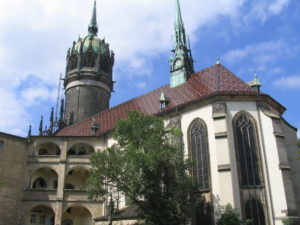-
A Square Dance in Heaven
- Posted on September 27, 2017
- by Nancy
- in Latest News, Spire link, Worship
- Comments Off on A Square Dance in Heaven

Castle Church, Wittenburg, Germany I, Doctor Martin Luther, wish all lovers of the unshackled art of music grace and peace from God the Father and from our Lord Jesus Christ! I truly desire that all Christians would love and regard as worthy the lovely gift of music, which is a precious, worthy, and costly treasure given to mankind by God. The riches of music are so excellent and so precious that words fail me whenever I attempt to discuss and describe them….
—Martin Luther (1483-1546)
Dear friends,
As many of you know, we at First Congregational Church are purposefully exploring the Reformation over eight weeks of Sunday morning worship. It is 500 years since Martin Luther (1483-1546) pinned his 95 Theses to the door of the Castle Church in Wittenberg, sparking what would come to be known as the Protestant Reformation, the 16th-century religious, political, intellectual and cultural upheaval that splintered Catholic Europe. In northern and central Europe, reformers challenged papal authority and questioned the Roman Church’s ability to define Christian practice. Perhaps what Luther, a professor of theology, really wanted was for God to be made accessible to everyone and for worship to be intimate and direct. The liturgical changes that eventually ensued naturally brought about musical changes, which differed from country to country according to the degree of reform advocated by the various Protestant leaders: Luther in Germany; Calvin and his followers in France, the Low Countries, and Switzerland; and Henry VIII in England.
Have you noticed a variety of Reformation hymns and anthems in our worship services thus far? From the most classical hymns to lesser known songs and refrains? (God Is my Rock jazz psalm refrain, Immortal, Invisible, How Firm a Foundation). This month, I thought we might pause for one moment and look at Martin Luther, the musician. Not only did Luther exercise a profound influence on the religious and cultural life of sixteenth century Europe, but he also freed music from the domination of the Roman Church, opening the door to a revolution in music. Luther began to compose hymns in 1523, the exact number of which has been, and remains, disputed. However, thirty-six hymns have survived (think Ein feste Burg or A Mighty Fortress). Additionally, Luther translated (into German) Latin texts and used the psalms and poems as the basis for many other hymns (Christ lag in Todesbanden or Christ Jesus Lay in Death’s Strong Bands). He was accomplished at the lute, the flute, and was known to have a powerful tenor voice. He was so committed to the high place of music in the life of the Church that men had to demonstrate competency in music before they could be accepted for ministerial training!
Luther enthused about music as the greatest gift of God after religion itself, and – wherever possible – he preserved much of the glorious polyphony of Catholic musical practice. But he also inaugurated a sort of musical democratization by which strong, simple melodies could be sung by the entire congregation. The Lutheran Church’s most distinctive and important musical innovation became the strophic hymn— called Choral or Kirchenlied (church song) in German and chorale in English— intended for congregational singing. The great cultural and religious schism of the 16th century equalized music and participation, creating a template for modern classical music. This is the origin of all hymnody today. Just as plainchant was the basis for musical expansion and elaboration for Catholic composers, so, too, the repertory of chorales became the starting point for a great deal of Lutheran church music from the sixteenth century until the time of Johann Sebastian Bach (1685–1750) and beyond.
Bach’s connection and admiration of Luther stemmed from his childhood – in particular, his early education. Born in 1685 in Eisenach in Thuringia, Bach spent three years at the Latin school that Luther had attended two centuries prior. Due in part to Luther’s efforts, Bach experienced firsthand the fruits of Luther’s emphasis on the importance of a sound Christian education and sturdy theological foundation. As a chorister, the young J.S. Bach would have sung hymns and metrical psalms written by Luther, both the words and the music. Lutheran melodies are richly threaded throughout Bach’s work. In December of this year, the choir will present Bach’s magnificent Magnificat, as a part of our traditional Lessons & Carols, an historical nod to the important legacy the Reformation gives us.
Martin Luther essentially inaugurated congregational singing in church. He recognized, “that music is the language of the human spirit” and because of that he got everyone singing in Saxony. Four hours of music each week was introduced into the school curriculum, and choirs sprang up in every town. Luther concluded, “When people engage in music, singing in four or five parts, it’s like a square dance in heaven!”
As an important P.S. to this little article, please note that Will and the ministry team have created a few opportunities for you to participate in this Reformation-palooza! October 1 marks the beginning of a four-week Reformation study, exploring the explosive ideas of a revolution born 500 years ago. For your convenience, these classes are offered at a variety of dates and times, scheduled for four Sunday evenings, four Tuesday evenings or four Tuesday mornings at the church. And Will and Judy continue their Sunday morning Reformation sermon series, culminating in a joyful celebration on October 29, honoring this rich and radical heritage. After the service that day, we will have an “expanded” German coffee hour (with German savories, sweets and beverages) – with a special guest appearance by Martin Luther himself! Please mark your calendar for these special events.
In faith,
—Jane Ring Frank, Minister of Music and Worship Arts






